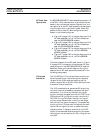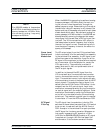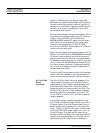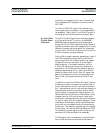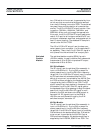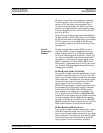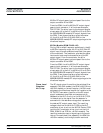
When the 683XXB is generating broad-band analog
frequency sweeps (>100 MHz wide), the main tun
-
ing coil current tunes the oscillator through the
sweep frequency range. Phase locking to fine adjust
the oscillator’s output frequency is only done at the
bottom and top of the sweep ramp and on both sides
of each band switch point. Narrow-band analog fre
-
quency sweeps (£100 MHz wide) in the 683XXB are
accomplished by summing the appropriate sweep
ramp signal into the oscillator’s FM tuning coil con
-
trol path. The YIG-tuned oscillator’s RF output is
then swept about a center frequency that is set by
the main tuning coil current. Phase locking to fine
tune the output frequency is done at the center fre
-
quency of the sweep.
Power Level
Control and
Modulation
The RF output signal from the YIG-tuned oscillator
is fed to connector J6 of the switched filter assembly.
In the switched filter assembly, the RF signal is am-
plified then goes to the modulator. A portion of the
RF signal to the modulator is picked off and coupled
out via connector J5 to the Sampler for use by the
YIG loop circuitry. The modulator provides for
power level control, AM, and pulse modulation of
the RF output signals.
In addition to the amplified RF signal from the
YIG-tuned oscillator, the modulator has two other
inputs—the modulator control input and the pulse
input. The modulator control input adjusts the gain
of the modulator to control the power level of the RF
output signals. The modulator control signal is re
-
ceived from the A9 PIN Control PCB where it is de
-
veloped from the ALC control signal. Amplitude
modulation is accomplished by varying the modula
-
tor control signal with the modulating signal. Pulse
modulation is achieved by switching the modulator
on and off at a rate determined by the modulating
pulse input. The modulating pulse input is received
via connector J7 from the A6 Pulse Generator PCB.
RF Signal
Filtering
The RF signal from the modulator is fed via PIN
switches to the switched low-pass filters. PIN switch
drive current is received from the A9 PIN Control
PCB. A coupler in the switched filter path provides
the RF signal for the down converter. Whenever an
instrument is generating RF signals of <2 GHz
(£2.2 GHz for 682X5B/683X5B models), a RF signal
is coupled out, through a 8.5 GHz low-pass filter
and connector J3 to the down converter. Another
682XXB/683XXB MM 2-23
FUNCTIONAL RF DECK
DESCRIPTION ASSEMBLIES
NOTE
For 683X5B models at frequencies
of £2.2 GHz, broad-band analog fre
-
quency sweeps are >25 MHz wide;
narrow-band analog frequency
sweeps are £25 MHz.








